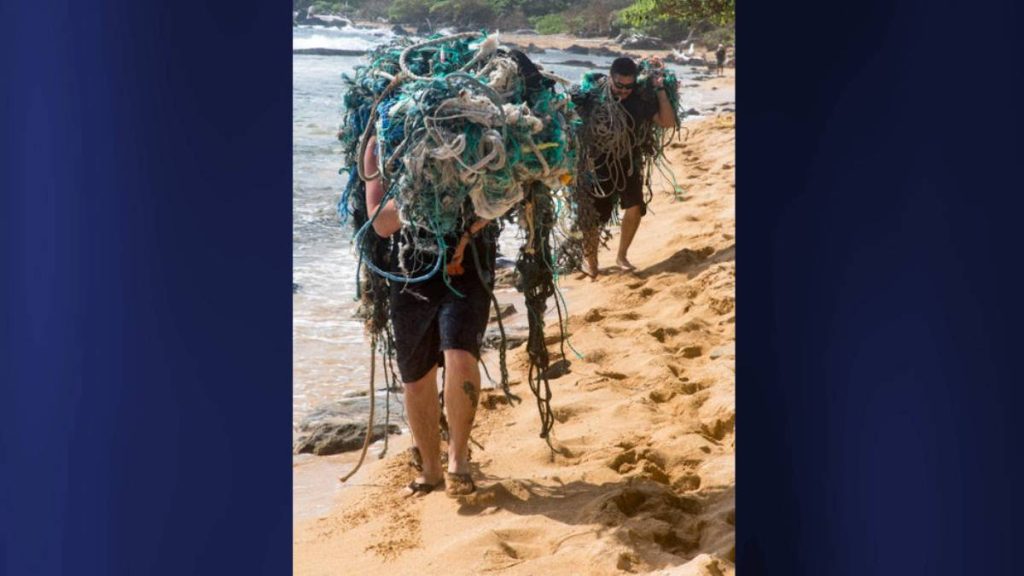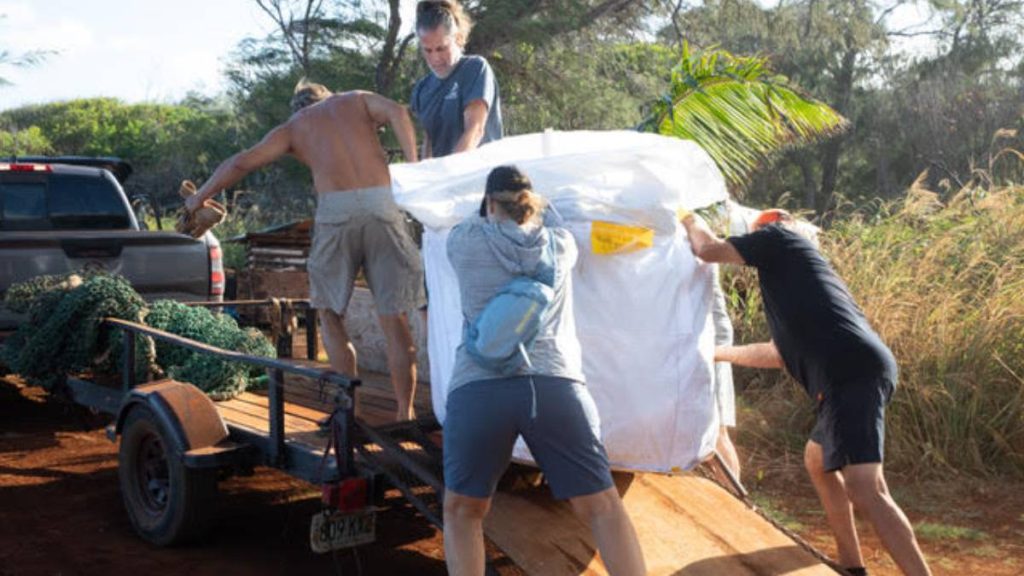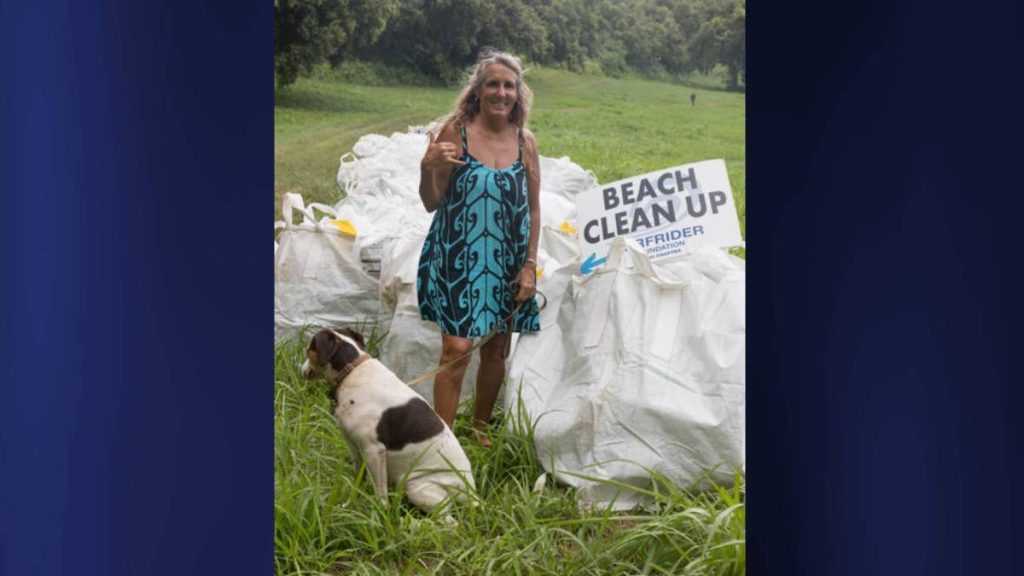Surfrider Kauaʻi continues focus on marine debris following release of annual report
The Surfrider Foundation released its annual 2023 beach clean-up report earlier this month, but the work of the local Kauaʻi chapter — which included over 123 clean-up events and nearly 50,000 pounds of trash — did not seem to be included.
According to the 2023 Annual Beach Cleanup Report, Surfrider reported 985 cleanups nationwide, with 34,600 volunteers collecting 225,270 pounds of trash. The report says Surfrider held just 2% of their total cleanups in Hawai’i, with 22 cleanups total throughout the state. Although the report doesn’t specify which islands the cleanups were held, a cleanup data tool on the national Surfrider website reports that there were just two cleanups held on Kaua’i in 2023.
However, multiple representatives of Surfrider Kaua’i, including its co-coordinator for beach cleanup and net patrol Barbara Wiedner, said the national data for Kaua’i was incorrect. “There’s so many (cleanups) we did,” she said.
Wiedner provided data showing that in 2023, the local chapter held 123 cleanups — divided into 20 beach cleanups and 103 net patrol events. “Net patrol” focuses on the fishing nets that wash ashore, most from commercial fishing operations, which bring in nets to Kaua’i shores often weighing more than 1,000 pounds that can entangle sea life.
The Surfrider Kauaʻi chapter removed 39,581 pounds of marine debris from beaches around the island, and 10,200 pounds of land-based trash, for a total of 49,788 pounds in 2023.
Wiedner said that Kaua’i Surfrider had sent the number of cleanups to the national organization. But, it may not have been included in the annual report due to the Kauaʻi focus on marine debris.
“I wouldn’t worry about it. We’re really over here, kind of doing our own thing because we do so much,” she said.
Surfrider USA did not immediately respond to questions about why Kauaʻi data wasn’t included in the annual report, but its Healthy Beaches Program Manager Jennifer Harrah instead sent the contact information for Surfrider Kaua’i members Welti and Wiedner. “They lead the cleanup efforts on Kauaʻi and would be able to help answer your questions and give you a great look at all the cleanup work that they’re a part of!” said Harrah in an email.
Wiedner explained that Surfrider Kauaʻi deals more marine debris coming from the North Pacific Gyre, a large system of rotating ocean currents that also contains the Great Pacific Garbage Patch.
According to a Surfrider Kauaʻi chart, the amount of marine debris collected in a year peaked in 2017 at roughly 120,000 pounds and has been steadily declining since then.
“We got the most in 2017 and 2018,” Wiedner said. “And then we started getting less and less.

Wiedner explained that in prior years, the organization had been finding nets weighing up to 3,000 or 5,000 pounds. She said those nets stopped washing up on the coastline in recent years. “There were really no giant nets coming in, or very few,” she said.
However, during the end of September 2023, Wiedner began receiving calls from the community about more nets being found.
“The gyre is moving back closer to Kaua’i,” she said of the increase in nets.
Surfrider and University of Hawaiʻi scientists recently published a paper on how the migration of the North Pacific Garbage Patch influences the amount of marine debris that washes up on Hawaiʻi shore annually.
The amount of marine debris appears to be rising again, at least according to data for the first half of 2024. Cynthia Welti, Surfrider Kaua’i marine debris analyst, provided data showing that from January through June of 2024, Surfrider Kaua’i has collected more pounds of marine debris than compared to all of 2023.
The 2024 data shows 42,267 pounds of trash has been collected so far this year, with over 41,000 pounds being marine debris from the ocean. 17,780 pounds of the marine debris came from fishing nets.
Aside from nets, the group frequently removed other marine debris including fishing gear, buoys, sacks, tires, plastic bottles, and other little pieces of trash.
Today, Surfrider and Hawai’i Pacific University have worked together to have a 20-foot container delivered to Kaua’i. The container will be filled with marine debris collected by Surfrider, and it will then be shipped back to the university located on Oʻahu to be studied by its research center.
They plan to use the marine debris to make infrastructure, according to Wiedner, who said the fishing nets aim to create spider ties – plastic strips that can hold together cement walls, houses, and other structures.
“The grant specifically is to repurpose marine debris, nets, and plastics to make infrastructure,” she said.
During the interview, Wiedner encouraged those in the community to look into the Surfrider Kauaʻi Chapter and consider getting involved.
“Marine debris or trash in the ocean is everyone’s responsibility, especially on Kaua’i,” Wiedner said.
“Our whales get entangled in the nets every year. And then the animals are eating the plastic because it looks, tastes, and smells like their food. And then the nets that are weighted down somehow or they sink to the bottom, they’re smothering our coral reef,” she said.
Those interested in volunteering can contact the Surfrider Kauaʻi hotline at 808-635-2593 to find out how to get involved in beach and net patrol cleanups, learn how to become an ocean-friendly visitor on Kaua’i or help with social media and information booths.
People can also contact the state hotline at 808-833-4-Da-Nets (833-432-6387) to report marine debris. “Wherever you call in the state of Hawaiʻi, you can call it,” Wiedner said. “I know it works.” The hotline is a collaboration between the state Department of Natural Resources, Sustainable Coastlines on O‘ahu, the Maui Ocean Center Marine Institute, Surfrider Foundation on Kaua‘i, and the Hawai‘i Wildlife Fund on Hawai‘i Island.













